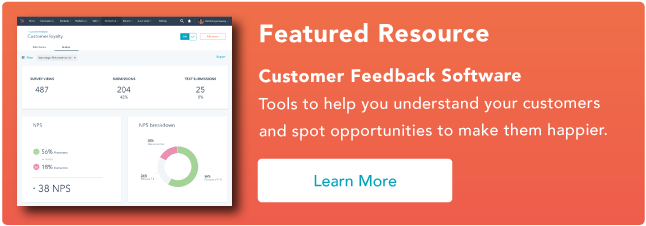What are customer insights?
Customer insights are the interpretation of data from customer feedback and other analytics to help businesses identify behavioral trends to improve the effectiveness of marketing, sales, and service initiatives.
With customer insights, quantitative and qualitative customer data is used to inform business decisions better. The goal is to identify behavioral trends and improve the buyer experience based on objective metrics.
Why are customer insights important?
A deeper understanding of customer psychology, behavior, and preference can better serve those customers and potentially increase revenue.
Direct data on your customers' user experience (UX) can prevent them from churning. If you can get to the bottom of their problems with fresh, authentic feedback from your customers, you can solve the problem they're experiencing before they become too dissatisfied.
We know that using this data will benefit your business, but you need to know how to collect actionable customer information before anything.
How to Gather Customer Insights
- Collect customer feedback.
- Get a pulse check on customer sentiment.
- Use third-party data for market research.
- Do some situational analysis.
- Passively collect behavioral data.
- Conduct real-time user testing.
- Use predictive modeling.
Since insights are more about the conclusions you can use to make decisions, you can reach those conclusions from various sources.
1. Collect customer feedback.
The easiest way to get customer insights is by simply asking them what they think. Surveys and “How Are We Doing?” style questionnaires can lead to powerful takeaways that can apply to future campaigns. For local businesses, this step is vital to understand how your customers deal with their problems for their niche or industry. A great example is Monarch Roofing who conduct post-roof installation reviews to uncover any issues the homeowner experienced during their roofing project. They can then take this feedback to apply to any new installation projects.
The challenge is that this mode alone may not give you the full picture. Many customers may be afraid or unwilling to share their true opinions or give minimum viable feedback to complete the survey.
2. Get a pulse check on customer sentiment.
Methods measuring customer sentiment, such as a Net Promoter Score (NPS) system and star ratings, are equally important as surveys. By asking customers to rate how they feel and removing the friction to do so — one-click popup, anyone? — you can begin to measure customer satisfaction with any digital experience. These are especially effective for in-app or on-page testing of a single feature and experiences after a sales call or customer service interaction.
3. Use third-party data for market research.
Suppose you don’t have much customer feedback to make decisions from. In that case, you can draw insights from market research performed by larger organizations with a broader audience. This can be done using keyword research tools such as Google Trends, Ahrefs, and SEMrush.
4. Do some situational analysis.
Customers may not know that something could be better until it comes along and metaphorically hits them in the face. This could be detrimental if an innovative competitor makes them aware, or it could mean customer delight if you improve.
However, if a customer doesn’t realize the flaws in a process, service, or product, how can they communicate it to you? In-person interviews, ongoing gap analysis, and training seminars may reveal insights that a survey never could — especially if they rely on open-ended questions.
5. Passively collect behavioral data.
You can learn much about your customers by noticing how they interact with your website, product, or content. Analytics platforms such as:
- Google Analytics: Social media dashboard
- Hotjar: Heat mapping software
- Lucky Orange: Screen recording software
These tools gather data that managers can use to draw more informed conclusions on. You can also get information about what prospects care about from searches they do online.
6. Conduct real-time user testing.
For apps, websites, and online-based experiences, you can gain insights into audience preferences by running A/B tests on certain experience variables. With A/B testing, you can watch in real time as your user base interacts with elements such as copy, navigation, and button color or placement to determine what works best. Majority rules, and you can draw statistical proof.
7. Use predictive modeling.
Predictive modeling or lead scoring is another source that some companies use to gain insights and make decisions. With machine learning and artificial intelligence, it’s becoming increasingly possible to use algorithms and statistical models to analyze large quantities of data and variables much better than you can without computer help. This can often be used to make “predictions” about user or customer experience.
Examples of Customer Insights
- PodcastGuests.com Customer Feedback Survey
- HubSpot's Net Promoter Score System
- Yokel Local's Bug Fix After Insights from Behavioral Data
- Csek Creative's A/B Testing
- Netflix's Machine Learning
1. PodcastGuests.com Customer Feedback Survey
PodcastGuests.com is a service that connects podcast hosts who need guests to podcast guests looking for shows. This service sent out a survey as part of its weekly email campaign.

What We Like: The beauty of their survey is that the questions they chose served two purposes:
- Gather meaningful feedback from subscribers to improve the experience
- Gather meaningful data from subscribers to ensure that the PodcastGuests.com email list is segmented properly
By asking questions that require respondents to choose an option, PodcastGuests could then use this information to send out more personalized emails with only the content that's helpful for the customer — helping their email campaigns and improving the experience.
2. HubSpot's Net Promoter Score System
At HubSpot, we use NPS and email marketing automation to gather and measure customer satisfaction. After a customer support ticket concludes, an email goes out to the customer asking to rate their experience from one to ten. From here, we use the data collected to determine if we're on the right track with our customer service efforts.

What We Like: This works particularly well because it's a one-click experience with no long list of survey questions to answer. Giving a straightforward way for our team to gauge whether our strategy is working or needs improvement.
3. Yokel Local ’s Bug Fix After Insights from Behavioral Data
Yokel Local, a digital marketing agency, noticed their conversions were worryingly low on the "Request a Consultation" page. After testing the form in-house, they could find no reason for the drop.
That’s when they took to Lucky Orange, a screen recording software, and began to watch real customer interactions with the site. They found a major user experience issue where some devices would not allow check box clicks, and the user would bounce away.

What We Like: This insight led to some web development work to correct the issue, and the conversions returned back to normal. Sometimes, things can look great on the surface but contain deceptive issues.
4. Csek Creative’s A/B Testing
When a company wants to change something as vital as its website homepage, there better be a good reason to do so. After all, there's no guarantee that the change is for the better. That's why a great practice is to A/B test the new copy against the old copy to see which version leads to a higher percentage of your desired result.
That's exactly what digital marketing agency Csek Creative did with their new tagline. What they thought would be a minor change resulted in an 8.2% increase in their click-through rate.

What We Like: The company's tests were conclusive and proved that changing the tagline on the home page would lead to a higher clickthrough rate — something that wouldn't have been done if the test was not held in the first place.
5. Netflix's Machine Learning
One of the best examples of machine learning to enhance customer experience is Netflix's recommendations engine.

What We Like: By analyzing each user’s interactions with other customers' preferences, Netflix can serve up content most likely to entertain. This increases customer satisfaction and the time they spend on the platform.
How to Apply Customer Insights
So, you've been running surveys across your digital platforms, and your customers have enthusiastically shared their thoughts. Now it's time to combine these valuable qualitative insights with analytics and make changes.
So where do you start? Get inspired by these use cases where customer feedback was the key to making a difference.
1. Make changes based on the result of user testing.
Customer feedback is a vital component of any testing phase. To ensure their Support portal revamp met users' needs, Usabilla first released it in beta and opened the floor for feedback.
Targeting a percentage of visitors to the existing site, Usabilla invited customers to test the new beta website. Once customers were on the site, they were highly willing to share their thoughts. Perhaps because they had been actively invited to try the page, making them more engaged with leaving feedback.

What We Like: Through a combination of passive feedback submitted via a Usabilla feedback button and running active surveys — using actionable questions based on the ones above — the company was able to both test and improve the beta website before rolling it out to the public.
2. Share your wins and ROI from the data you receive.
French football club Paris Saint-Germain saw an incredible return on investment after implementing user feedback to ask for customers' contact details. Hugo Charrier, Ecommerce Manager at PSG, explains:
"We decided to run a slide-out campaign where customers could leave their details if they didn't have time to complete the process for purchasing a VIP ticket, or in case they had any further questions. As a result, we received over 500 email addresses which, in turn, generated almost €100,000 worth of sales!"

What We Like: Gathering valuable customer data doesn't necessarily need to involve surveys or open-ended questions. Sometimes simply opening the channel for communication can make a big difference.
Use Your Customer's Experience to Innovate
It's clear that becoming a truly data-driven and user-centric company requires a combination of quantitative and qualitative sources. Reaching out for customer feedback can be manageable, and if you have a solid feedback platform, it can help you deliver the seamless digital experience your customers want.
Net Promoter, Net Promoter System, Net Promoter Score, NPS and the NPS-related emoticons are registered trademarks of Bain & Company, Inc., Fred Reichheld and Satmetrix Systems, Inc.
Editor's note: This article was originally published in April 2020 and has been updated for comprehensiveness.
Customer Feedback




![How to Write a Thank You Letter for Customer Feedback [Templates]](https://53.fs1.hubspotusercontent-na1.net/hubfs/53/thank-you-letter-for-customer-feedback-1-20241003-1267887.webp)


.png)

-1.png)


